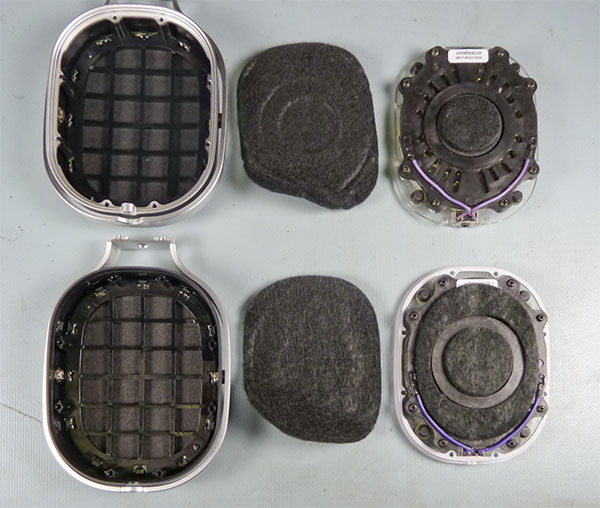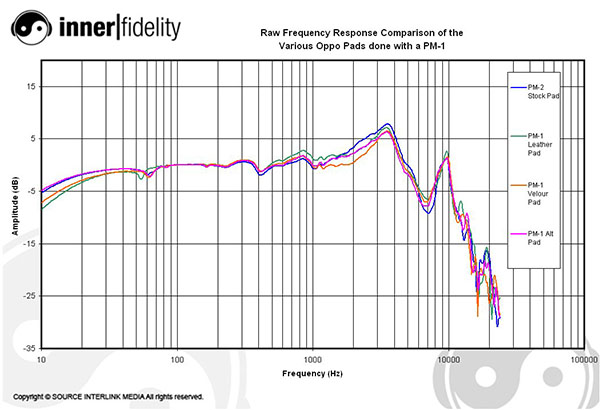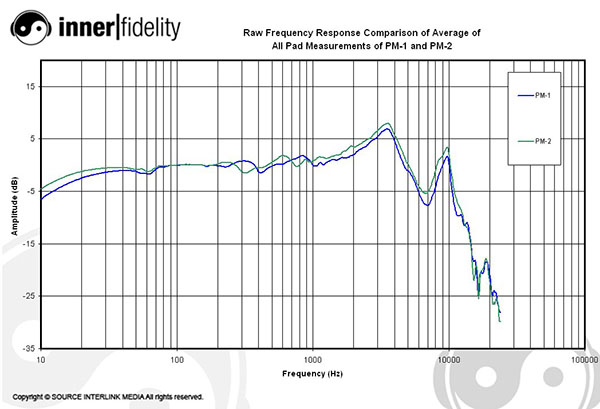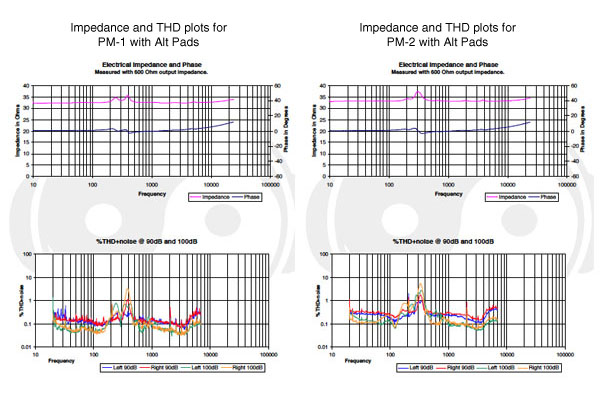| Columns Retired Columns & Blogs |
Portable Luxury at a Lower Price: The Oppo PM-2

This story originally appeared at InnerFidelity.com
In the photo above you'll see the PM-1 (top) and PM-2 (bottom) capsules disassembled. In both headphones there is a large free-floating piece of acoustic felt between the driver and housing rear. I've bent up the corner of this felt in the photo above so that you could see the felt in the PM-1 is substantially thicker than that in the PM-2—unfortunately, it's not easy to observe. You'll also notice the PM-2 has an extra piece of "O"-shaped felt glued to annular slots around the outer magnet. Both drivers have a felt circle glued to the central opening.
Oppo PM-2 ($699)
The Oppo PM-2 was released not long after the Oppo PM-1 as a lower cost alternative. The PM-2 forgoes the fancy presentation box, extra ear-pads, and balanced cable, leaving the denim clam-shell case, short mobile cable, and longe unbalanced cable (OFC instead of OCC) as the included accessories. On the headphones themselves, ear-pads and headband pad coverings switch from lamb-skin to synthetic leather, and a couple of the trim pieces on the ear capsule are now plastic instead of metal. All told, I think these were excellent choices in creating a lower cost version of the PM-1.
In my previous PM-1 review I noted that the included 1.1 meter cable for mobile use was too short fo my liking. I'm very happy to see that Oppo has now made available a 1.8 meter version of this cable. You can find it, and all the replacement pads and cables for the PM-1 and PM-2 here.
I'm not going to do my normal physical description here as interested readers can read my Oppo PM-1 review for the rundown—other than the modest changes noted above, these cans are virtually identical. Well...that's not quite true, there is a small difference in the damping behind the driver, and the PM-2 pad does sound slightly different than the PM-1 Alternate pads. This review then will go into detail about the slight differences between the PM-1 and PM-2, and will dig a bit deeper into the various permutations with the available ear-pads.

Ear-capsules disassembled to show damping behind driver in the PM-1 (top) and PM-2 (bottom).
Differences in Damping Behind DriverIn the photo above you'll see the PM-1 (top) and PM-2 (bottom) capsules disassembled. In both headphones there is a large free-floating piece of acoustic felt between the driver and housing rear. I've bent up the corner of this felt in the photo above so that you could see the felt in the PM-1 is substantially thicker than that in the PM-2—unfortunately, it's not easy to observe. You'll also notice the PM-2 has an extra piece of "O"-shaped felt glued to annular slots around the outer magnet. Both drivers have a felt circle glued to the central opening.
I do think these changes in internal damping have slightly changed the sound of the PM-2 relative to the PM-1, making the new cans slightly brighter through the low-and mid-treble, and giving the bass a very slight boost. With all the permutations of pads and the two versions of these cans, changes are small but audible, and important to understand for getting the best out of these fine headphones. We'll look at some of the measured differences first, and then I'll make some recommendations.
Pad Differences
Rather than duplicate a lot of information on the four pad variants, I'll refer you to this article that describes the four pads in detail. In that article I also measured the four pads on the PM-2 and showed a comparison graph. I've updated this graph aligning the four traces at about 100Hz as I think it does a better job of highlighting the differences.

I've now done the same experiment with the PM-1, here are the results.

At first glance it appears that pads make a bit more difference on the PM-2 than on the PM-1. It also appears the differences made seem to be a little lower in frequency with the PM-1 than PM-2. It's worth mentioning at this point that we need to be careful of reading too much into these measurements. The differences measured between the pads and two headphones are relatively small, and measurement errors could creep in that large enough to invalidate what we're seeing here.
However, I do think it's fair to note that the PM-2 stock pad had the highest peak at 3.5kHz, and the lowest dip at 7kHz. I'm not entirely certain of this (currently doing a lot of reading about headphone acoustics that should clear things up a bit), but it's my impression that the peak at 3kHz and dip at 7kHz is related to the resonance of the chamber between the driver and the ear. It seems to me that we're seeing pads that vary the quality of resonance in that region.
The quality of a resonator (often simply called the resonator's Q) is a measure of how long it will ring at its resonant frequency. For example, a bell has a high Q—strike it and it will ring for a long time. But wrap that same bell with a sleeping bag, and it will ring for a much shorter period of time. Damping lowers the Q of a resonator.
The various pads offered by Oppo change the Q of the resonance between the driver and ear. The higher the Q, the higher the peak at the resonant frequency (3.5kHz) and a lower dip at anti-resonant frequencies (7kHz). From the PM-2 plots it appears the PM-2 stock pad has the least damping (highest Q), followed by the PM-1 Alternate Pads, and then the original PM-1 leather pads and velour pads having the most damping. I found it a little hard to tell which of the last two have the most damping; my ears tell me the velour pads but I also hear some subtle EQ changes between those two pads so it's hard to tell. The fact that the pads make less difference on the PM-1 than the PM-2 leads me to believe the PM-1 is a slightly more damped headphone overall.
If you look at the photo earlier on this page that shows the two headphone capsules disassembled, you can see that the PM-2 large felt piece is significantly thinner than the PM-1. However the PM-1 has an extra piece over the annular vents. The two thicknesses are about the same when you add the second piece in the PM-2. But! If you look carefully at the PM-1 felt there are distinct impressions from the circular feature (outer magnet holder) behind the driver.
My guess at this point is that this compression of the felt in the PM-1 is making the felt a bit more dense, which increases the damping effect behind the driver. This increase in damping effect behind the driver in the PM-1 is assisting in decreasing the Q of the resonances in front of the driver as well. The result is that the pads have a bit less effect in the PM-1 than they do in the PM-2. That's my guess anyway.
Differences Between the PM-1 and PM-2
To ferret out the differences between the two headphones I decided to simply average the measurements of all the pads for each headphone. Since the raw headphone measurement is comprised of the average of five headphone measurements in slightly different positions, the measurements shown below are an average of 20 different headphone measurements (5 measurements for each of the 4 different pads) and, it seems to me, is a good way to get at the exact measured differences between the two headphones.

Here you can see clearly a slight increase in sub-bass energy below 40Hz, and a lift in low- to mid-treble energy between about 1kHz and 10kHz for the PM-2. Since the PM-1 was widely regarded as a slightly mid-centric headphone, I think the move to a slightly brighter sound with a bit more bass emphasis is a wise move, tastefully done, for the PM-2.
The other noticeable change in frequency response is the movement of some bumps and wiggles between 200Hz and 800Hz. Decreasing the density of the padding behind the driver of the PM-2 effectively increases the air volume of that space, which in turn will lower the resonant frequencies slightly. As you can see, the features in the PM-2 curve do indeed look like they've moved lower in frequency.
Another place to better see some of these changes is in the impedance and distortion response plots of the two headphones. I have not averaged these responses, but I will show a representative sample of these measurements using the Alternate Pads on the two headphones.

Plots for the PM-1 at left above show two distinct peaks in the impedance and THD+noise plots at 250Hz and 400Hz. In the PM-2 plots to the right we can see these peaks shift lower in frequency (about 200Hz and 300Hz) and the lower frequency bump become significantly reduced. We can also see the double bump of the THD plot change to become dominated by the higher frequency peak, and we can see that the primary bump indicates more distortion in the 90dB sweep than in the PM-1 THD plot. (It's probably worth mentioning that the PM-2 plots are slightly higher overall—I suspect this is due to more ambient noise in my lab environment on that day contributing to a higher noise floor during the measurement. It should probably be ignored.)
Alrightythen, measurements definitely show some differences between the various pads and the PM-1 and PM-2 in general, Turn the page and we'll talk about the listening experience.
- Log in or register to post comments




































